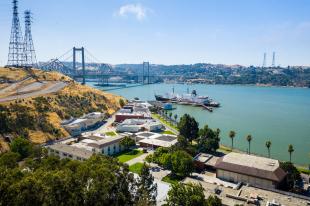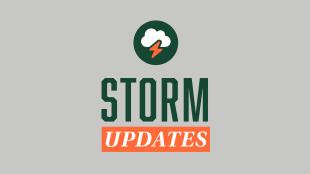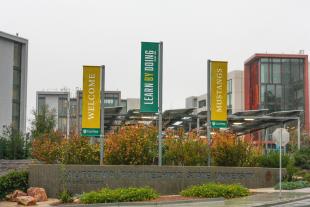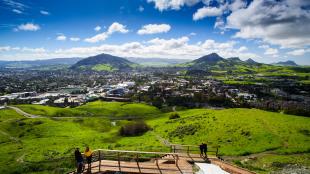President Armstrong: An Update on Boosters, Masks and In-Person Activities During Omicron
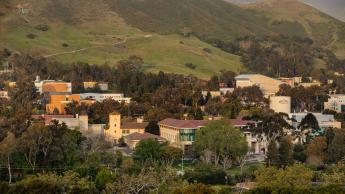
This message originally appeared as an email from President Jeffrey D. Armstrong to students and employees on January 13, 2022.
To Cal Poly’s Faculty, Staff and Students:
I am writing to pass along a note that has just been sent to students regarding how they can upload their COVID-19 booster information with the university. Similar guidance will be forthcoming for non-represented employees, and, after we complete meet-and-confer, for represented employees.
Like many of you, I and the senior administration have watched the current Omicron variant surge with concern. I wanted to take this opportunity to reiterate the reasoning underlying our decision to return to in-person classes — and to thank all of you for your hard work and the grace and flexibility that you have shown, especially toward our students during these first two weeks of the quarter.
Our starting point for thinking about the winter quarter has been basic but easy to overlook: We are in the midst of a pandemic and there are no perfect solutions. Every option available to us represents both consequences and benefits, risks and rewards. Our highest priority is ensuring the safety of our entire community. It is never part of our calculations to put some at risk so that others may benefit. Rather, we always seek the solutions that protect everyone in our community and serve our overriding goal of providing the best education possible.
Cal Poly has been prepared for the Omicron surge and has put a great deal of thought and planning into its response. We have always known we would detect a high number of COVID-19 positive students as we went through mandatory testing the first week back on campus — it was inescapable. We also knew students were moving back to the SLO area (as they did when we were all virtual last year) whether we started the quarter in-person or virtually. However, by making the decision to be in-person, it allowed us a critical advantage — the ability to mandate testing for the entire student body. This is a true difference maker, as it enables us to identify and separate those who are COVID-19 positive from those who are not. Had we chosen a different path, the infected — the majority of whom have been asymptomatic—would have unknowingly gone on to infect and potentially sicken many of their fellow students, coworkers and neighbors. Similarly, if we were virtual, we would not have had the same ability to require students to have the COVID-19 vaccine and booster — the steps most likely to reduce serious illness.
Another consideration in our decision to return to in-person classes is the fact that our university uniquely has its own COVID-19 surveillance lab and can process thousands of students per day on campus. The university tested all 21,000+ students within approximately one week of their arrival and found that about 5% of samples collected from asymptomatic students showed presence of the virus. Incidentally, we have seen that virtual classes have not resulted in a lower incidence of COVID-19 at other universities, where many are seeing infection rates much higher than ours. In our case, it was critical to very quickly test and identify those who were infectious and isolate them from those who were not. This allows us to minimize future spread and lower the infection curve.
I also want to address a point about isolating students at off-campus facilities. Having isolation beds available off campus at hotel sites, in addition to those we have on campus, has always been a part of our plans. It is well documented that this is something we did during previous surges to manage cases and it has proven to be a very effective solution. Like all of our plans, it is also something that has long been endorsed by our county public health officer and the infectious disease experts who have helped us develop our strategies.
Between identifying and isolating positive cases right away, mandating the vaccines/boosters and requiring masks indoors, we are doing everything possible to protect our campus community and contain the virus while also offering a top-quality educational experience.
As anticipated, we have had to make some adjustments along the way in response to the evolving pandemic and Omicron specifically. One of those is our guidance on masking. I know there have been some concerns about which masks will be most effective in preventing infection. Our health advisors agree that N95/KN95 masks are the most effective, but also confirm that surgical masks worn correctly are also highly effective.
Surgical masks are available in many places across campus and there are large numbers available at three designated points: the University Union, Kennedy Library and the Recreation Center. N95/KN95 masks will be available starting January 13 at the University Union and Rec Center for employees only. We continue to watch closely the latest developments from the CDC, the county and our public health experts regarding masks and will update our guidance to campus if there are changes.
Uncertainty is always unsettling and worrying and Omicron represents the latest wave of real concern. There is no zero-risk scenario, but we have learned a great deal from the previous phases of the pandemic and are in a position to help everyone stay safe while continuing the important work of educating our students.
In closing, I want you to know that I am moved by your dedication, your work, your insights, and your flexibility as we navigate these difficult waters together. Thank you for your partnership.
Sincerely,
Jeffrey D. Armstrong
President
To read the message to students about uploading booster info, visit the Campus Updates page of Cal Poly's coronavirus website.

